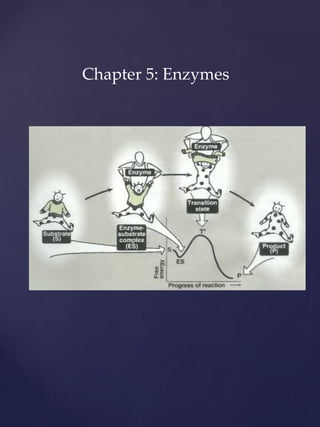
Enzyme part 1
- 2. Enzymes are biological catalysts—i.e., substances of biological origin that accelerate chemical reactions. Figure 1
- 3. An enzyme acts up on a molecule (reactant), which is termed a substrate, to produce a new product. E: Product A:Substrate Figure 2 B:Enzyme D:Enzyme C: Enzyme-substrate complex Note that the enzymes are not consumed during the reaction they catalyse (enzymes can be reused).
- 5. Virtually every step in metabolism is catalyzed by an enzyme. Example of different enzymes in some metabolic pathways Figure 3 JFI
- 6. Enzyme Nomenclature -Traditionally, enzymes often were named by adding the suffix -aseto the name of the substrate upon which they acted, as in urease for the urea-hydrolyzingenzyme or phosphatase for enzymes hydrolyzingphosphoryl groups from organic phosphate compounds. -Other enzymes acquired names bearing little resemblance to their activity, such as the peroxide-decomposing enzyme catalase or the proteolytic enzymes (proteases) of the digestive tract, trypsin and pepsin,their names give no hint of the associated enzymatic reaction
- 8. The oxidoreductases (class 1) catalyzethe transfer of reducing equivalents from one redox system to another. (EC.1) The transferases (class 2) catalyzethe transfer of other groups from one molecule to another. Oxidoreductases and transferasesgenerally require coenzymes.(EC.2) The hydrolases (class 3) are also involved in group transfer, but the acceptor is always a water molecule.(EC.3)
- 9. Lyases (class 4, often also referred to as “synthases”) catalyze reactions involving either the cleavage or formation of chemical bonds, with double bonds either arising or disappearing. (EC.4) The isomerases (class 5) move groups within a molecule, without changing the composition of the substrate. (EC.5) The ligation reactions catalyzed by ligases (“synthetases,” class 6) are energy-dependent and are therefore always coupled to the hydrolysis of nucleoside triphosphates. (EC.6) any of a class of enzymes that remove groups from their substrates (other than by hydrolysis,oxi), leaving double bonds, or that conversely add groups to double bonds.
- 12. As an example, the formal systematic name of the enzyme catalyzing the reaction: ATP + D-glucose ADP + D-glucose 6-phosphate isATP:glucosephosphotransferase, which indicates that it catalyzes the transfer of a phosphoryl group from ATP to glucose. Its Enzyme Commission number (E.C. number) is 2.7.1.2. (2) denotes the class name(transferase). (7) the subclass (phosphotransferase). (1) a phosphotransferasewith a hydroxyl group as acceptor. (2) D-glucose as the phosphoryl group acceptor.
- 13. -The glucose-specific enzyme, E.C.2.7.1.2, is called glucokinaseand the nonspecific E.C.2.7.1.1 is known as hexokinase. -Kinase is a trivial term for enzymes that are ATP-dependent phosphotransferases. -These designations can be cumbersome, so in everyday usage, trivial names are employed frequently.
- 14. Enzyme properties 1- Active sites The active site is a special pocket or cleft of the enzyme that interacts with the substrate. The active site contains amino acid side chains that create a three-dimensional surface complementary to the substrate. Figure 5
- 15. 2-Specifity: each enzyme is specific for one and ONLY one substrate (one lock - one key). Thrombin reacts only with the protein fibrinogen, and is part of a very delicate blood-clotting mechanism. Not all enzymes are as highly specific, digestive enzymes such as pepsinand chymotrypsin, are able to act on almost any protein.
- 17. Coenzymes: are organic moleculesthat are often vitamin derivatives (NAD+,FAD , Coenzyme A).
- 19. Each second, each enzyme transform 100 to 1000 substrate molecules into product.
- 20. The number of molecules of substrate converted to product per enzyme molecule per second is called Turnover number.-What is KATAL? What is enzyme unit U? 1 U=? Katal -Don’t Confuse IU(used for biological activity) with U
- 21. 5-Regulation Enzymatic activity can be regulated, meaning they can be activated or inhibited. The rate of product formation is regulated in response to the needs of the cell.
- 22. 6-Location within cells Many enzymes are localised in specific organelles within the cell Figure Figure 6 Intracellular location of some important biochemical pathways (not for now).
- 23. The compartmentalisation helps in the following: -it serves to isolate the substrate or product from other competing reactions. -it provides a favourable environment for the reaction. -it organise thousands of enzymes present in the cell into purposeful pathways.
